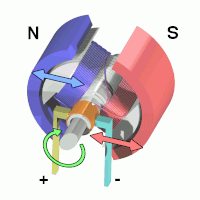
Photo from wikipedia
An improved performance of a photovoltaic (PV) pumping system employing a synchronous reluctance motor (SynRM) under partial shading conditions is proposed. The system does not include the dc–dc converter that… Click to show full abstract
An improved performance of a photovoltaic (PV) pumping system employing a synchronous reluctance motor (SynRM) under partial shading conditions is proposed. The system does not include the dc–dc converter that is predominantly being utilized for maximizing the output power of the PV array. In addition, storage batteries are also not contained. A conventional inverter connected directly to the PV array is used to drive the SynRM. Further, a control strategy is proposed to drive the inverter so that the maximum output power of the PV array is achieved while the SynRM is working at the maximum torque per Ampère condition. Consequently, this results in an improved system efficiency and cost. Moreover, two maximum power point tracking (MPPT) techniques are compared under uniform and partial shadow irradiation conditions. The first MPPT algorithm is based on the conventional perturbation and observation (P&O) method and the second one uses a differential evolution (DE) optimization technique. It is found that the DE optimization method leads to a higher PV output power than using the P&O method under the partial shadow condition. Hence, the pump flow rate is much higher. However, under a uniform irradiation level, the PV system provides the available maximum power using both MPPT techniques. The experimental measurements are obtained to validate the theoretical work.
Journal Title: IEEE Access
Year Published: 2019
Link to full text (if available)
Share on Social Media: Sign Up to like & get
recommendations!